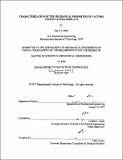Characterization of the mechanical properties of tactors used in tactile displays
Author(s)
Held, David (David A.)
DownloadFull printable version (31.62Mb)
Other Contributors
Massachusetts Institute of Technology. Dept. of Mechanical Engineering.
Advisor
Lynette A. Jones.
Terms of use
Metadata
Show full item recordAbstract
Pancake motors used in a tactile display were analyzed to understand the characteristics of their operation, as well as to suggest improvements in the design of the display. The frequencies and forces produced by unencased and encased pancake motors were measured, and a motor model was formulated to simulate the motion of the motors. It was found that there was considerate variability between pancake motors, and it was proposed that this may be due to a varying damping coefficient. A viscoelastic substrate, named Skinsim, was selected based on mechanical tests to have similar material properties to skin. It was found that when the motors were mounted on Skinsim their frequency of vibration was reduced by 62%. Measurements of the effects of damping in Skinsim led to the recommendation that inter-tactor spacing on a tactile vest should be at least 60 mm if the display is to be used for precise tactor localization. Finally, a GPS device was integrated into the tactile display. This allows appropriate navigational commands to be sent to the user through the tactile vest, based on information about the user's location.
Description
Thesis (S.M.)--Massachusetts Institute of Technology, Dept. of Mechanical Engineering, 2007. Includes bibliographical references (leaves 97-99).
Date issued
2007Department
Massachusetts Institute of Technology. Department of Mechanical EngineeringPublisher
Massachusetts Institute of Technology
Keywords
Mechanical Engineering.